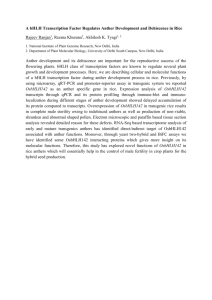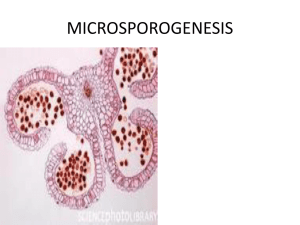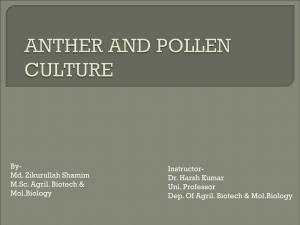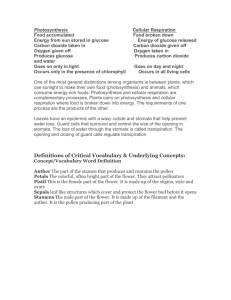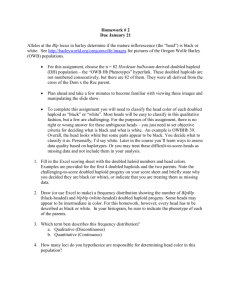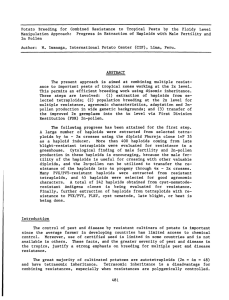Anther Culture
advertisement
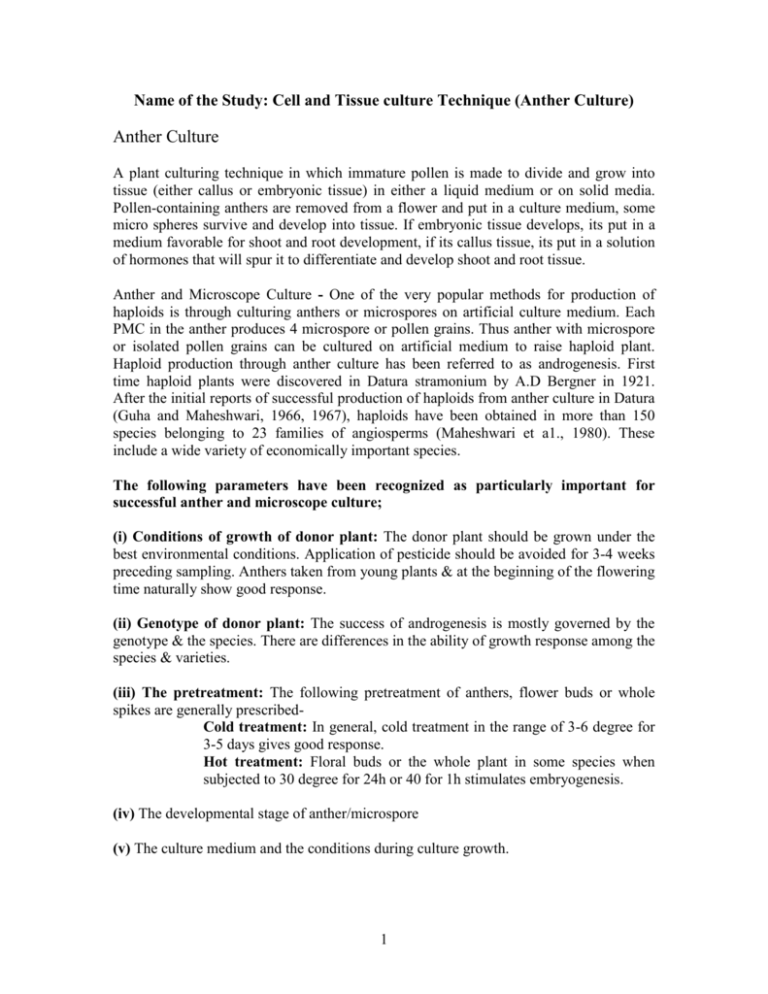
Name of the Study: Cell and Tissue culture Technique (Anther Culture) Anther Culture A plant culturing technique in which immature pollen is made to divide and grow into tissue (either callus or embryonic tissue) in either a liquid medium or on solid media. Pollen-containing anthers are removed from a flower and put in a culture medium, some micro spheres survive and develop into tissue. If embryonic tissue develops, its put in a medium favorable for shoot and root development, if its callus tissue, its put in a solution of hormones that will spur it to differentiate and develop shoot and root tissue. Anther and Microscope Culture - One of the very popular methods for production of haploids is through culturing anthers or microspores on artificial culture medium. Each PMC in the anther produces 4 microspore or pollen grains. Thus anther with microspore or isolated pollen grains can be cultured on artificial medium to raise haploid plant. Haploid production through anther culture has been referred to as androgenesis. First time haploid plants were discovered in Datura stramonium by A.D Bergner in 1921. After the initial reports of successful production of haploids from anther culture in Datura (Guha and Maheshwari, 1966, 1967), haploids have been obtained in more than 150 species belonging to 23 families of angiosperms (Maheshwari et a1., 1980). These include a wide variety of economically important species. The following parameters have been recognized as particularly important for successful anther and microscope culture; (i) Conditions of growth of donor plant: The donor plant should be grown under the best environmental conditions. Application of pesticide should be avoided for 3-4 weeks preceding sampling. Anthers taken from young plants & at the beginning of the flowering time naturally show good response. (ii) Genotype of donor plant: The success of androgenesis is mostly governed by the genotype & the species. There are differences in the ability of growth response among the species & varieties. (iii) The pretreatment: The following pretreatment of anthers, flower buds or whole spikes are generally prescribedCold treatment: In general, cold treatment in the range of 3-6 degree for 3-5 days gives good response. Hot treatment: Floral buds or the whole plant in some species when subjected to 30 degree for 24h or 40 for 1h stimulates embryogenesis. (iv) The developmental stage of anther/microspore (v) The culture medium and the conditions during culture growth. 1 Importance: Crosses between distantly related species can bring together novel gene combinations. However, the hybrid offspring can be few in number, genetically unstable and require years of further selection and screening before any advantageous characteristics can be brought near to commercial use. Anther culture (androgenesis), to generate haploid plants from pollen microspores, is one way to shorten this process. It allows novel allele combinations, particularly ones involving recessive characters, to be assessed in intact plants. Useful individuals can then be developed into homozygous and fertile plants through chromosome doubling techniques, and brought into a breeding programme. the technique is fairly simple it is easy to induce cell division in the immature pollen cells in some species a large proportion of the anthers used in culture respond (induction frequency is high) ▪ Haploids can be produced in large numbers very quickly Some disadvantages of using anther culture to obtain haploids are: when working with some species, the majority of plants produced have been nonhaploid in cereals, very few green plants are obtained; many of the plants are albinos or green-albino chimeras it is tedious to remove the anthers without causing damage sometimes a particular orientation is necessary to acheive a desired responce Pathways of Development: The early division in responding pollen grains may occur in one of the following four ways (1) the uninucleate pollen grain may divide symmetrically to yield two equal daughter cells both of which undergo further divisions. (2) In some other cases, the uninucleate pollen divides unequally (as it does in nature). The generative cell degenerates callus/embryo originates due to successive division of the vegetative cell.( 3) In few species the pollen embryos originate from the generative cell alone; the vegetative cell either does not divide or divides only to a limited extent forming a suspensor like structure (4) finally in some species, the uninucleate pollen grain divide unequally producing generative & vegetative cells, but both these cells divides repeatedly to contribute to the developing embryo/callus. The responsive pollen grains become multicellular & ultimately burst open to release the cell mass. The cell mass may either assume the shape of a globular embryo & undergo the developmental stages of embryogeny or it may develop into a callus depending on the plant species. 2 3 Procedure: Young flower bud with immature anther at the appropriate stage of pollen development is surface sterilized & rinsed with sterile water. The buds are dissected by removing the sepals & petals. The anthers are carefully dissected from the flower buds & kept in a petridish. Each anther is gently separated from the filament & the intact uninjured anthers are placed horizontally on nutrient medium. If the flowers are very small a sterio microsecope can be used for dissecting the anthers. Isolated healthy anthers are cultured on agar medium or in a liquid medium. The anther burst open within 3-8 weeks of culture. After they have attained a height of about 3-5 cm the individual plantlets or shoots emerging from the callus are separated & transferred to a medium that would support further development. The rooted plants are transferred to soil mix in the pots. Application of Haploids in agriculture: 1. Reduction of time in developing variety of self pollinated crop: A conventional plant breeding programe takes about 6-8 years to develop a pure homozygous line, where as by the use of anther/microspore culture, homozygous plants can be produced by saving 4 years of time. In general, anthers from F1 hybrids of selected or desirable crosses are cultured to produce haploid which chromosome no,. is doubled. A large no. of pure lines are then grown to select the best superior line. The lines can be released as variety. Alternatively, this line can be used in hybridization programe. Thus it shortens the breeding cycle, saves time, space & labour. 2. Production of pure line of self-incompatible species 4 Self incompatibility prevents homozygosity in some field & tree species. In these cases, development of 100% homozygous pure lines can be achieved through androgenesis. 3. Hybrid production in crop Hybrid production in crop requires pure lines. Anther culture helps to develop 100% homozygous pure lines in short period of time. Diploidization of haploids rapidly fix traits in the homozygous condition. Pure lines can be used for the production of pure F1 hybrid. 4. Study of mutation Haploids are very useful for the study of mutation. Recessive characters are expressed without any dominant suppression. Mutations can easily be detected. 5. Induction of genetic variability By anther culture not only haploids but also plants of various ploidy levels & mutants are obtained & can be incorporated into the breeding programe. 6. Fusion of protoplast of haploid cell Protoplast of haploid cells is ideal material for gene transfer through cell fusion technology. 7.7. Cytogenetic research: Haploids are used to develop aneuploidy in some crops. Production of aneuploid in wheat & tobacco were achieved by the use of haploid technology. 8. Allow breeding at the haploid level; Breeding of autotetraploid crops like potato, alfalfa etc. sometimes shows problems due to their complex segregation patterns. Breeding at the haploid level through hybridization & selection & then restoring the tetraploid stage by chromosome doubling help to obtain vatieties in the crops like potato. 9. Development of super males in Asparagus Haploids in Asparagus officinalis are developed by anther culture, which are diploidized to form homozygous males & females. Crosses between the homozygous males (super males, MM) & females (mm) yielded homogeneous F1 hybrids with all male seeds. 10. Selection of resistant lines Haploid cells or plants are used for the selection of resistance against biotic & abiotic stresss. For developing disease resistant lines, the toxins of the pathogen are used in the anther culture medium & selection is carried out for the surviving cells or plants. The cells are then cultured for the plant regeneration by providing appropriate media. The haploid plants are then treated with colchicines to make them doubled haploid. Screening for salt resistance can be done by providing NaCl at different concentrations in the anther culture medium. The surviving plantlets are cultured in optimum growth medium & finally in sterile soil for the confirmation & testing. 5 Limitations 1. The application of this technique is not yet possible in many crops where proper protocol is not yet developed. 2. High level of management & expertise are required to operate the tissue culture production of haploid. 3. Mixture of different ploidy levels makes the task difficult. 4. Relatively high incidence of albinism in some types of anther & pollen culture is defected. 5. The lack of selection of traits during the derivation of haploid material. 6. In some cases, the doubling of a haploid does not always result in the production of a homozygote. Diploidization of Haploids Plants - Haploid plants obtained either from anther or ovule culture may grow normally under in vitro conditions up to the flowering stage but viable gametes are not formed due to the absence of one set of homologous chromosomes and, consequently, there is no seed set. The only mechanism for perpetuating the haploids is by duplicating the chromosome complement in order to obtain homozygous diploids. In pollen derived plants duplication of chromosomes may occur spontaneously in cultures but due to the small percentage of such double-haploids it is necessary to diploidize the haploids by chemical means. A simple procedure designed to achieve diploidization involves immersion of very young haploids in a filter sterilized solution of colchicine (0.4%) for 2-4 days, followed by their transfer to the culture medium for further growth. In this procedure chromosome or gene instabilities are minimal compared to other methods of colchicine or chemical treatment. Vicinity Cleave 6

